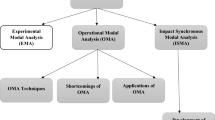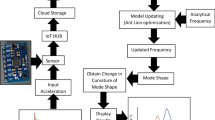Abstract
Operational modal analysis (OMA) methods are frequently applied for obtaining information on structural dynamic parameters, such as natural frequencies and mode shapes. While synchronization between acceleration response data sets used in OMA is not a prerequisite for estimating natural frequencies, synchronization discrepancies may lead to non-negligible errors in the estimation of mode shapes. Synchronization discrepancies are predominantly associated with wireless structural health monitoring systems, where each wireless sensor node functions as a separate data acquisition unit (DAQ), and clock synchronization is therefore not intrinsic. However, synchronization discrepancies may also occur in cable-based systems, particularly when more than one DAQ is used. In this paper, a synchronization method for detecting and correcting synchronization-induced errors in OMA is proposed. Unlike existing approaches on removing synchronization-induced errors at the output stage, the method proposed herein yields synchronized structural response data at an intermediate stage of OMA. Specifically, time lags between acceleration response data sets are detected based on estimates of the mode shapes obtained either from preliminary structural analysis or from engineering judgment assuming classical damping. The applicability of the proposed method is verified through simulations of a multi-degree-of-freedom oscillator and validated through ambient vibration field tests on a pedestrian overpass bridge.
















Similar content being viewed by others
References
Adams, D.E.: Health Monitoring of Structural Materials and Components: Methods with Applications. Wiley, Hoboken (2007)
Farrar, C.R., Worden, K.: Structural Health Monitoring: A Machine Learning Perspective. Wiley, Hoboken (2012)
Smarsly, K., Hartmann, D., Law, K.H.: An integrated monitoring system for life-cycle management of wind turbines. Int. J. Smart Struct. Syst. 12(2), 209–233 (2013)
Peeters, B.: System identification and damage detection in civil engineering structures. Ph.D. Dissertation, KU Leuven, Leuven, Belgium (2000)
Smarsly, K., Hartmann, D., Law, K.H.: A computational framework for life-cycle management of wind turbines incorporating structural health monitoring. Struct. Health Monit. Int. J. 12(4), 359–376 (2013)
Saisi, A., Gentile, C., Guidobaldi, M.: Post-earthquake continuous dynamic monitoring of the Gabbia Tower in Mantua, Italy. Constr. Build. Mater. 81, 101–112 (2015)
Dragos, K., Smarsly, K.: A hybrid system identification methodology for wireless structural health monitoring systems based on dynamic substructuring. In: Proceedings of the SPIE Smart Structures/NDE Conference: Sensors and Smart Structures Technologies for Civil, Mechanical, and Aerospace Systems, Las Vegas, NV, USA, 24/03/2016 (2016)
Zhang, L., Brincker, R., Andersen, P.: An overview of operational modal analysis: major development and issues. In: Proceedings of the 1st International Operational Modal Analysis Conference, Copenhagen, Denmark, 26/04/2005 (2005)
Ubertini, F., Comanducci, G., Cavalagli, N., Laura Pisello, A., Luigi Materazzi, A., Cotana, F.: Environmental effects on natural frequencies of the San Pietro bell tower in Perugia, Italy, and their removal for structural performance assessment. Mech. Syst. Signal Process. 82, 307–322 (2017)
Magalhães, F., Cunha, Á., Caetano, E.: Vibration based structural health monitoring of an arch bridge: from automated OMA to damage detection. Mech. Syst. Signal Process. 28, 212–228 (2012)
Comanducci, G., Magalhães, F., Ubertini, F., Cunha, Á.: On vibration-based damage detection by multivariate statistical techniques: application to a long-span arch bridge. Struct. Health Monit. 15(5), 505–524 (2016)
Deraemaeker, A., Reynders, E., De Roeck, G., Kullaa, J.: Vibration-based structural health monitoring using output-only measurements under changing environment. Mech. Syst. Signal Process. 22(1), 34–56 (2008)
Ubertini, F., Comanducci, G., Cavalagli, N.: Vibration-based structural health monitoring of a historic bell-tower using output-only measurements and multivariate statistical analysis. Struct. Health Monit. 15(4), 438–457 (2016)
Brincker, R., Ventura, C.: Introduction to Operation Modal Analysis. Wiley, Chichester (2015)
Krishnamurthy, V., Fowler, K., Sazonov, E.: The effect of time synchronization of wireless sensors on the modal analysis of structures. Smart Mater. Struct. 17(5), 055018 (2008)
García-Palacios, J., Tirando-Andrés, E., Soria, J.M., Díaz, I.M., Araujo, Á.: Effects of time synchronization on operational modal analysis. In: Proceedings of the 6th International Operational Modal Analysis Conference, Gijón, Spain, 12/05/2015 (2015)
Rainieri, C., Fabbrocino, G.: Operational Modal Analysis of Civil Engineering Structures: An Introduction and Guide for Applications. Springer, New York (2014)
Smarsly, K., Law, K.H., König, M.: Autonomous structural condition monitoring based on dynamic code migration and cooperative information processing in wireless sensor networks. In: Proceedings of the 8th International Workshop on Structural Health Monitoring, Stanford, CA, USA, 09/13/2011 (2011)
Youn, S.: A comparison of clock synchronization in wireless sensor networks. Int. J. Distrib. Sensor Netw. 2013, ID532986 (2013)
Sundararaman, B., Buy, U., Kshemkalyani, A.D.: Clock synchronization for wireless sensor networks: a survey. Ad-Hoc Netw. 3(3), 281–323 (2005)
Ranganathan, P., Nygard, K.: Time synchronization in wireless sensor networks: a survey. Int. J. UbiComp 1(2), 92–102 (2010)
Bojko, T., Lisowski, W., Bednarz, J.: Problems of development of wireless sensors for experimental modal analysis. Diagnostyka 3(51), 49–58 (2009)
Dinçer, S., Aydin, E., Gencer, H.: A real-time instrumentation approach for structural health monitoring of bridges. In: Proceedings of the Istanbul Bridge Conference, Istanbul, Turkey, 11/08/2014 (2014)
Peeters, B., Sforza, G., Sbaraglia, L., Germano, F.: Efficient operational modal testing and analysis for design verification and restoration baseline assessment: Italian case studies. In: Proceedings of the 4th International Conference on Experimental Vibration Analysis for Civil Engineering Structures, Varenna, Italy, 03/10/2011 (2011)
Fernández-Lorenzo, G. W., Mercerat, D., Santisi d’Avila, M. P., Bertrand, E., Deschamps, A.: Operational modal analysis of a highrise RC building and modelling. In: Proceedings of the 6th International Operational Modal Analysis Conference, Gijón, Spain, 12/05/2015 (2015)
Magalhães, F., Caetano, E., Cunha, Á.: Operational modal analysis of the Braga sports stadium suspended roof. In: Proceedings of the 24th International Modal Analysis Conference, St. Louis, MO, USA, 02/02/2006 (2006)
Wang, L., Xu, Q.: GPS-free localization algorithm for wireless sensor networks. Sensors 10(2010), 5899–5926 (2010)
Whelan, M.J., Gangone, M.V., Janoyan, K.D., Jha, R.: Real-time wireless vibration monitoring for operational modal analysis of an integral abutment highway bridge. Eng. Struct. 31(10), 2224–2235 (2009)
Van Greunen, J., Rabaey, J.: Lightweight time synchronization for sensor networks. In: Proceedings of the 2nd ACM International Conference on Wireless Sensor Networks and Applications, San Diego, CA, USA, 19/09/2003 (2003)
Severino, R., Gomes, R., Alves, M., Sousa, P., Tovar, E., Ramos, L.F., Aguilar, R., Lourenço, P.B.: A wireless sensor network platform for structural health monitoring: enabling accurate and synchronized measurements through COTS\(+\) custom-based design. In: Proceedings of the 5th Conference on Management and Control of Production and Logistics, Coimbra, Portugal, 08/09/2010 (2010)
Maggs, M.K., O’Keefe, S.G., Thiel, D.V.: Consensus clock synchronization for wireless sensor networks. IEEE Sens. 12(6), 2267–2277 (2012)
Stojmenovic, I.: Handbook of Sensor Networks. Algorithms and Architectures. Wiley, Hoboken (2005)
Maes, K., Reynders, E., Rezayat, A., De Roeck, G., Lombaert, G.: Offline synchronization of data acquisition systems using system identification. J. Sound Vib. 381, 264–272 (2016)
Zhu, Y.-C., Au, S.-K.: Spectral characteristics of asynchronous data in operational modal analysis. Struct. Control Health Monit. 2017, e1981 (2017)
Brincker, R., Brandt, A.: Time synchronization by modal correlation. In: Proceedings of the 4th International Operational Modal Analysis Conference, Istanbul, Turkey, 09/05/2011 (2011)
Ferrari, R., Pioldi, F., Rizzi, E., Gentile, C., Chatzi, E. N., Serantoni, E., Wieser A.: Fusion of wireless and non-contact technologies for the dynamic testing of a historic RC bridge. Meas. Sci. Technol. 27(12), 124014 (2016)
Chatzi, E., Fuggini, C.: Structural identification of a super-tall tower by GPS and accelerometer data fusion using a multi-rate Kalman filter. In: Proceedings of the 3rd International Symposium on Life-Cycle Civil Engineering (IALCCE 2012), Vienna, Austria, 03/10/2012 (2012)
Smyth, A., Wu, M.: Multi-rate Kalman filtering for the data fusion of displacement and acceleration response measurements in dynamic system monitoring. Mech. Syst. Signal Process. 21(2), 706–723 (2007)
Rosenblum, M., Pikovsky, A., Kurths, J., Schäfer, G., Tass, P.A.: Phase synchronization: from theory to data analysis. In: Moss, F., Gielen, S. (eds.) Handbook of Biological Physics, vol. 4, pp. 279–321. Elsevier, Amsterdam (2001)
Ibrahim, S.R.: Existence and normalization of complex modes in post experimental use in modal analysis. In: Silva, J.M.M., Maia, N.M.M. (eds.) Modal Analysis and Testing, pp. 441–452. Kluwer Academic Publishers, Dordrecht (1999)
Dragos, K., Smarsly, K.: Distributed adaptive diagnosis of sensor faults using structural response data. Smart Mater. Struct. 25(10), 105019 (2016)
Liang, Z., Lee, C.G.: Damping of structures: part 1—theory of complex damping. Technical Report NCEER-91-0004. National Center for Earthquake Engineering Research, State University of New York, Buffalo, NY, USA (1991)
Caughey, T.K., O’Kelly, M.E.J.: Classical normal modes in damped linear dynamic systems. J. Appl. Mech. 32(3), 583–588 (1965)
STN EN-1991: Eurocode 1: Actions on structures. Part 1–4: general actions—wind actions. European Institute for Standardization (CEN), Brussels (2010)
Newmark, N.M.: A method of computation for structural dynamics. ASCE J. Eng. Mech. 85(3), 67–94 (1959)
Skafte, A., Aenlle, M.L., Brincker, R.: Cross orthogonality check for structures with closely spaced modes. In: Proceedings of the 33rd International Modal Analysis Conference, Orlando, FL, USA, 02/02/2015 (2015)
Brincker, R., Zhang, L.: Frequency domain decomposition revisited. In: Proceedings of the 3rd International Operational Modal Analysis Conference, Portonovo, Italy, 04/05/2009 (2009)
Computers and Structures, Inc.: SAP 2000 Integrated Finite Element Analysis and Design of Structures: Version 19. Computers and Structures, Inc., Berkeley (2013)
KYOWA: ASW-A Waterproof Acceleration Transducer Specification Sheet. KYOWA Electronic Instruments, Ltd., Tokyo (2017)
KYOWA: PCD 300A Sensor Interface Specification Sheet. KYOWA Electronic Instruments, Ltd., Tokyo (2004)
PCB Piezotronics Vibration Division: Seismic ICP Accelerometer (Model Number: 393A03) Specification Sheet. PCB Group Inc, Depew (2008)
Instruments, National: NI USB-6002 DAQ Device Specification Sheet. National Instruments Corporation, Austin (2014)
Brandt, A.: Noise and Vibration Analysis. Signal Analysis and Experimental Procedures. Wiley, Chichester (2011)
Acknowledgements
The authors gratefully acknowledge the support offered by the German Research Foundation (DFG) under Grant SM 281/14-1 for the initiation of the German–Greek collaboration. We would also like to acknowledge the support offered by DFG through the research training group GRK 1462 entitled “Evaluation of Coupled Numerical and Experimental Partial Models in Structural Engineering.” The valuable assistance provided by Dr. Panayiotis Panetsos, project manager at Egnatia Odos S.A., in making the pedestrian overpass bridge available for ambient vibration measurements is also acknowledged. Finally, the authors also wish to acknowledge the financial support provided by the Thuringian Ministry for Economic Affairs, Science and Digital Society (TMWWDG) and the Open Access Publication Funds of Bauhaus University Weimar. Major parts of this work were conducted in the “Structural Health Monitoring Laboratory,” sponsored by the European Union through the European Fund for Regional Development (EFRD) and TMWWDG under Grant 2016 FGI 0009. Any opinions, findings, conclusions, or recommendations expressed in this paper are those of the authors and do not necessarily reflect the views of the sponsors.
Author information
Authors and Affiliations
Corresponding author
Additional information
Publisher's Note
Springer Nature remains neutral with regard to jurisdictional claims in published maps and institutional affiliations.
Rights and permissions
About this article
Cite this article
Dragos, K., Makarios, T., Karetsou, I. et al. Detection and correction of synchronization-induced errors in operational modal analysis. Arch Appl Mech 90, 1547–1567 (2020). https://doi.org/10.1007/s00419-020-01683-6
Received:
Accepted:
Published:
Issue Date:
DOI: https://doi.org/10.1007/s00419-020-01683-6




